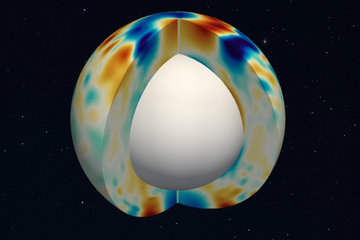All genres
1.
Journal Article
Inferring the magnetic field vector in the quiet Sun II. Interpreting results from the inversion of Stokes profiles. Astronomy and Astrophysics 547, A89 (2012)
2.
Journal Article
The continuum intensity as a function of magnetic field II. Local magnetic flux and convective flows. Astronomy and Astrophysics 542, A96 (2012)
3.
Journal Article
Inferring the magnetic field vector in the quiet Sun I. Photon noise and selection criteria. Astronomy and Astrophysics 527, A29 (2011)
4.
Journal Article
The Continuum Intensity as a Fuction of Magnetic Field. I. Active Region and Quiet Sun Magnetic Elements. Astronomy and Astrophysics 531, A112 (2011)
5.
Journal Article
Universal Scaling Law for Jets of Collapsing Bubbles. Physical Review Letters 107 (20), 204501 (2011)
6.
Journal Article
High-resolution spectro-polarimetry of a flaring sunspot penumbra. Astronomy and Astrophysics 505, pp. 771 - 790 (2009)
7.
Journal Article
Discriminant analysis of solar bright points and faculae. I. Classification method and center-to-limb distribution. Astronomy and Astrophysics 502, pp. 303 - 314 (2009)
8.
Journal Article
Techniques for generating centimetric drops in microgravity and application to cavitation studies. Exp. Fluids 47 (1), pp. 39 - 48 (2009)
9.
Journal Article
Evidence of convective rolls in a sunspot penumbra. Astronomy and Astrophysics 488, pp. L17 - L20 (2008)
10.
Journal Article
Cavitation bubble dynamics inside liquid drops in microgravity. Physical Review Letters 97, 094502 (2006)
11.
Conference Paper
Multi-Channel Observations of a Solar Flare. In: Solar Polarization 5: In Honor of Jan Stenflo, pp. 125 - 130 (Eds. Berdyugina, S. V.; Nagendra, K. N.; Ramelli, R.). (2009)
12.
Conference Paper
Center to Limb Distribution of Bright Points and Faculae: First Results of an Automated Detection Algorithm. In: Solar Polarization 5: In Honor of Jan Stenflo, pp. 211 - 214 (Eds. Berdyugina, S. V.; Nagendra, K. N.; Ramelli, R.). (2009)
13.
Thesis - PhD
Center-to-limb investigations of solar photospheric magnetic features at high spatial resolution. Dissertation, Georg-August-Universität Göttingen (2010)











